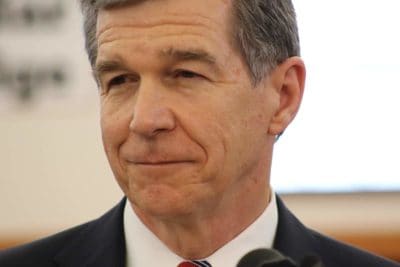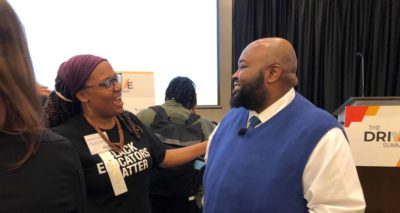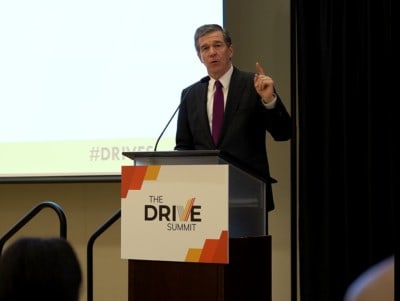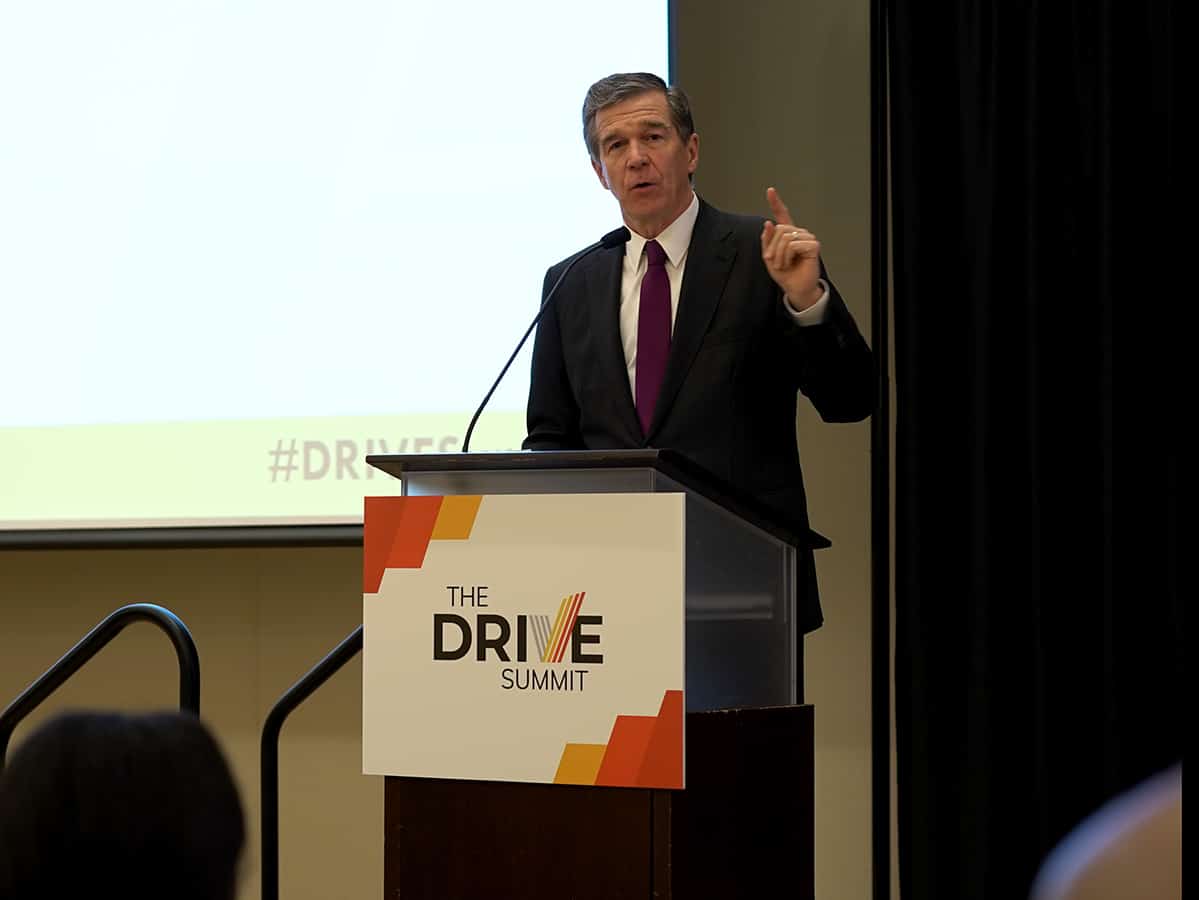

|
|
The DRIVE Task Force for diversifying the North Carolina teacher workforce officially entered a new phase on Tuesday, when it met to discuss synergies between its work and state-level efforts and commit to advocating for implementation of its recommendations.
DRIVE, which stands for Developing a Representative & Inclusive Vision for Education, is the name Gov. Roy Cooper gave the 34-person task force he established in December 2019 “to tackle the issue and measure goals to get to the kind of workforce we need for every child to have a chance.”
The task force spent a year developing recommendations and delivered its final report to Cooper three months ago. The report was a milestone, though, not a finale.
“Our work as a collective did not end with the submission of the DRIVE report,” said Anthony Graham, provost at Winston-Salem State University and the task force’s chair. “We have an incredible opportunity to advocate for the DRIVE recommendations and to ensure that our work has a lasting impact on the educator workforce in North Carolina.”
The task force heard about initiatives underway by Cooper, legislation pending in the General Assembly, and nonprofit groups who are working on related issues.
“I just want you to be assured that this work is indeed transferring into actionable items,” Graham said. “There’s still more work for us to do … but the recommendations are not sitting on someone’s shelf, collecting dust, and that was our commitment and promise to you from the very beginning.”
A recap of DRIVE and its recommendations
As the state’s non-white student enrollment continues to rise, so too does the percentage gap between students and teachers of color. In the 2018-19 school year, 53% of North Carolina public school students were non-white, up 10 percentage points from the 2005-06 school year.
By comparison, in 2018-19, only 21% of teachers were non-white, only a 4 percentage point increase from 2005-06.
This, while “extensive research has found that a diverse educator workforce is beneficial to all students, but especially students of color,” according to the report, which cited 11 different studies.
The final report laid out 10 recommendations:
- Offer affordable postsecondary access through scholarships, loan forgiveness, and tuition reimbursement programs to encourage diverse people to become teachers.
- Expand and develop entry points into the educator pipeline that are based on models with proven success in recruiting racially, ethnically, and linguistically diverse educators.
- Embed diversity goals into key performance indicators for schools and districts across the state.
- Provide sustainable investments in educator preparation programs at North Carolina’s Historically Minority Serving Institutions to elevate and build capacity of these institutions to increase their impact as leaders in equity-minded educator preparation.
- Adopt evidence-based elements of successful national residency models across the state’s educator preparation programs.
- Revise the North Carolina Professional Teaching Standards to directly incorporate anti-racist, anti-bias, culturally responsive, and sustaining pedagogy and require Educator Preparation Programs (EPPs) to report how they incorporate these proficiencies across their course offerings and programming.
- Invest in state- and district-level initiatives that increase the sustainability of the profession by strengthening support networks for educators of color and providing professional development that strengthens practice and fosters inclusive school environments.
- Develop and sustain pathways for advancement that are tailored to the needs of educators of color.
- Release an annual statewide Educator Diversity Report that tracks North Carolina’s progress in developing and sustaining a representative educator workforce.
- Establish a body to monitor North Carolina’s progress towards implementation of the Task Force’s recommendations.
The report also included several suggestions and four explicit goals, such as working to increase the number of educators of color admitted into the state’s educator preparation programs by 15% each year. In 2020, about 1,424 students of color were admitted into such programs compared to 3,403 white students.
The report also set a goal to retain at least 95% of the state’s educators of color.
What’s next for DRIVE?
Graham said the recommendations and strategies from this report can move the needle on teacher workforce diversity, but the state has to be willing to explore uncharted territory and demonstrate patience while trying new practices.
Those are future issues, though, as the state must first decide to implement task force recommendations and strategies. The call to action for task members now is to advocate for that.
“It is my hope that today’s presentations will help you reflect on how you can advocate as an individual for our collective work of developing an inclusive and representative vision for education,” Graham said.
The meeting included a brief summary of state lobbyist laws, intended to assure members that their work as part of the task force is exempt from laws that require registration as lobbyists.
Throughout the meeting, task force members heard about initiatives that present partnership opportunities, bills that could help advance the task force’s work, and other groups which share similar missions.
Opportunities to partner with state agencies and systems
Charrise Hollingsworth, a policy fellow in Cooper’s office, said the governor’s education cabinet heard a presentation of the DRIVE recommendations from Graham in February and voiced interest in implementing them.
Each agency and system represented on the cabinet was asked to designate a “DRIVE liaison” to coordinate with Cooper’s office to assess overlapping initiatives and resources as well as capacity constraints that need to be addressed to fully implement the DRIVE recommendations.
Hollingsworth said her office already identified some strategies being addressed at state-level agencies and systems. These include increasing recruitment efforts for educators of color by reallocating resources for first- and second-year college students and supporting the development of pathways to EPPs, particularly for aspiring educators of color.
“These strategies would benefit from more targeted efforts in order to fully implement the recommendations from the task force,” she said.
The agency and system liaisons are expected to meet prior to the next DRIVE meeting in June.
State Board and PEPSC transforming teacher prep pathways
Geoff Coltrane, Cooper’s senior education advisor, updated the task force on work between the Southern Regional Education Board (SREB) and the State Board of Education, including the State Board’s Professional Educator Preparation and Standards Commission (PEPSC).
Since 2018, a North Carolina Education Human Capital Roundtable has met for discussions facilitated by SREB for transforming the teaching profession in North Carolina. The vision was presented to the State Board of Education in February and sent to the PEPSC to further build out the policy. PEPSC subcommittees started meeting for this work at the end of March.
Coltrane said the changes are designed to move from a compliance-based system to an outcomes-based system that promotes student growth, effective teaching, and recruitment and retention of excellent teachers.
“It’s really a paradigm shift that no other state has undertaken,” he said.
An unintended consequence of the current system, Coltrane said, is a narrow entrance to teacher preparation on the front end and then a failure to consider effectiveness of teachers on the back end.
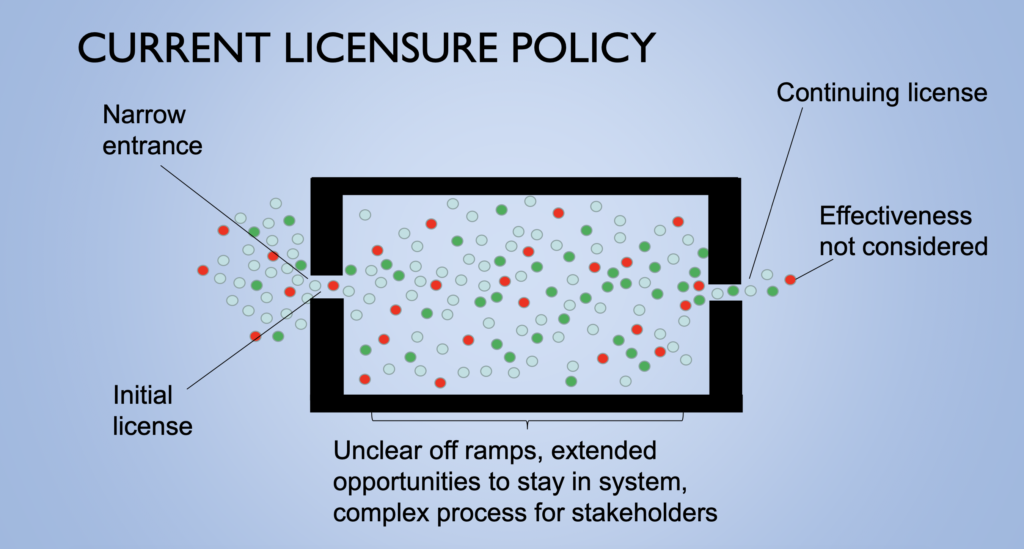

“Some of the policies tend to disproportionately impact people of color,” Coltrane said.
The policy now being envisioned would broaden the entryway, which will hopefully create more opportunities for diverse candidates, and create off ramps for teachers not demonstrating effectiveness.
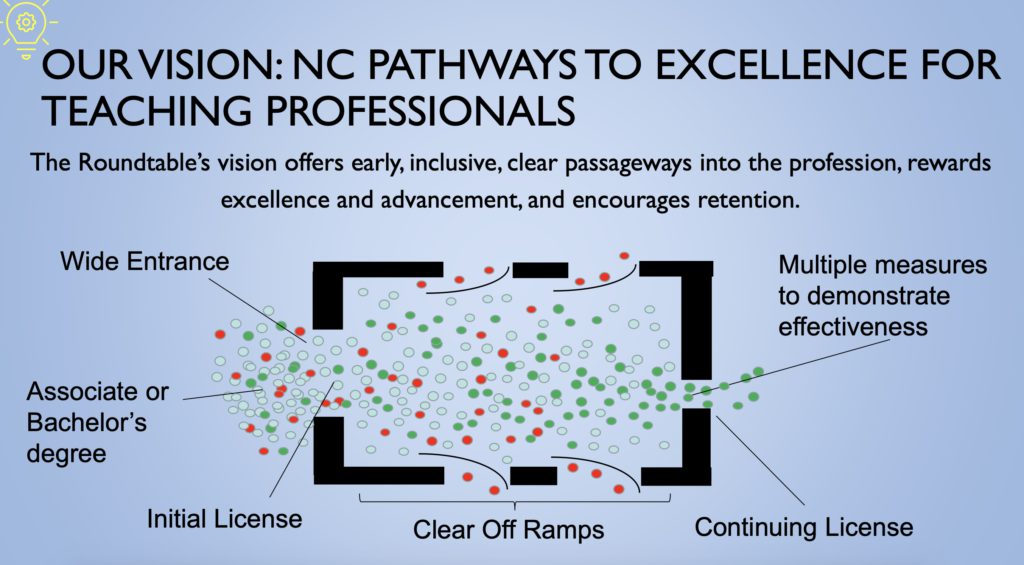

Related legislation the DRIVE Task Force is watching
Hollingsworth also updated members on legislation related to the task force’s work. Here are four bills the task force is watching:
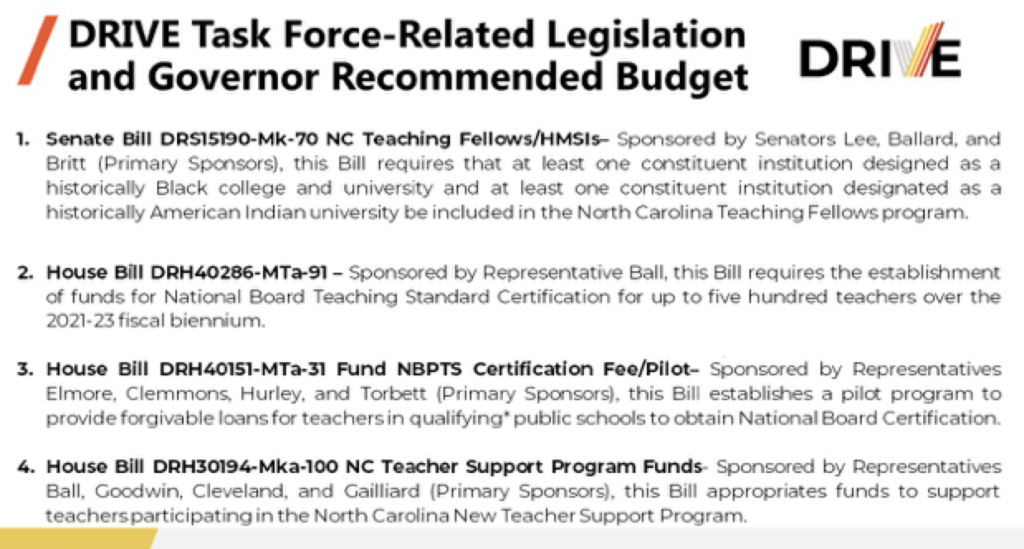

Opportunities to partner with nonprofits
Brenda Berg, president and CEO of BEST NC, spoke to the task force about NC STRIDE, which is a working group trying to elevate teacher recruitment. Berg said the group is focused on filling hard-to-staff subjects, ensuring students have access to high-quality teachers, and ensuring the state’s teacher workforce is diverse.
“These two entities have really been working in parallel to each other and in many ways coordinated together,” Berg said. “There are so many initiatives right now that are overlapping and (have) been kind of coming together over the last several years. This is just one of them.”
In fact, NC STRIDE identified five critical strategies, and the first of these is to create a teacher recruitment entity, likely housed in the Department of Public Instruction, to quarterback the various efforts in the state.
“There are so many great things happening across the state,” Berg said, “but synthesizing them together and sharing our best practices is really critical for making North Carolina the best place in the nation for teacher recruitment.”
Mary Ann Wolf, executive director for the Public School Forum, also spoke to task force members about the Dudley E. Flood Center. The Flood Center, which launched last year, focuses on equity and what that means each day for students across the state.
“We are diving into this work,” Wolf said. “And very much the focus already, I believe, builds upon the work of the DRIVE Task Force.”



